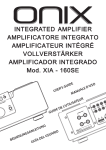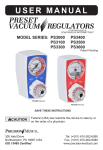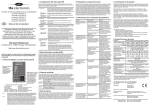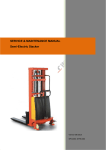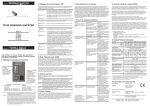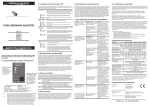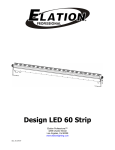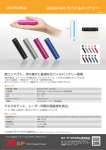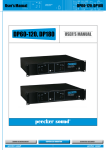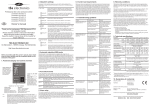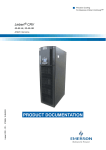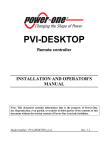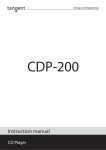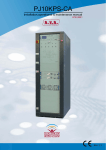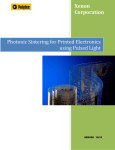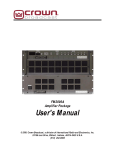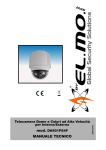Download PS_amps_manual - Peecker Sound
Transcript
User’s Manual TEMP TEMP PROTECT PROTECT SIG/CLIP SIG/CLIP R BRIDGE - + 2 1 3 CH A BRIDGE - 0 - 0 CH B INPUTS GND OUTPUTS CH C BRIDGE - 0 BRIDGE D C INPUTS BRIDGE MIN 8 A/B MIN 4 + PIN1 2 PIN1 2 D + C POWER INPUT PS amps 0 + SPEAKER IMPEDANCE BRIDGE MIN 8 C/D MIN 4 + PIN1 2 PIN1 2 BRIDGE CH D OUTPUTS SPEAKER IMPEDANCE STEREO SOUND REINFORCEMENT PS amplifiers C-D A-B A B 2 1 3 GND BRIDGE A SERIAL NO: AC 230V 10% 50Hz-60Hz CONTROLLED CONTROLLEDRADIATION RADIATION 1 B STEREO EARTH USER’S MANUAL ACOUSTIC RESEARCH User’s Manual TEMP TEMP PROTECT PROTECT SIG/CLIP SIG/CLIP PS amplifiers POWER R BRIDGE - + 2 1 3 CH A BRIDGE - 0 INPUTS GND - 0 CH B OUTPUTS CH C BRIDGE - 0 BRIDGE D C AC 230 50Hz-60H INPUTS + SPEAKER IMPEDANCE BRIDGE MIN 8 C/D MIN 4 + PIN1 2 PIN1 2 BRIDGE 0 OUTPUTS SPEAKER IMPEDANCE STEREO CH D BRIDGE MIN 8 A/B MIN 4 + PIN1 2 PIN1 2 D + C C-D POWER INPUT A-B B A STEREO B 2 1 3 GND BRIDGE A SERIAL NO: TABLE OF CONTENTS EARTH AC 230V 10% 50Hz-60Hz 1. IMPORTANT SAFETY INSTRUCTIONS pag. 3 2. DECLARATION OF CONFORMITY pag. 3 3. WARRANTY pag. 3 4. USER LIABILITY pag. 4 4.1 Damage to speakers 4.2 Dangerous output voltage 4.3 Radio interferences 5. INTRODUCTION pag. 4 5.1 Unpacking 5.2 Installation 5.3 Front panels 5.4 Rear panels 6. BRIEF DESCRIPTION OF THE SERIES pag. 7 7. OPERATING INSTRUCTIONS pag. 8 7.1 Connection to the AC mains supply and power absorption 7.2 Cooling 7.3 Connection cables 7.4 Configurations 8. PROTECTION SYSTEM FEATURES pag. 10 8.1 Limiter 8.2 Thermal protection 8.3 Load safety control 8.4 DC protection 8.5 Power on/off transients 9. TESTING PROCEDURE FOR ELECTRO-MECHANICAL OPERATION pag. 10 9.1 Required equipment 9.2 Visual check 9.3 Electrical testing procedures 10. TECHNICAL SPECIFICATIONS SOUND REINFORCEMENT CONTROLLED RADIATION 2 pag. 12 ACOUSTIC RESEARCH User’s Manual TEMP TEMP PROTECT PROTECT SIG/CLIP SIG/CLIP PS amplifiers R BRIDGE - CH A BRIDGE - 0 CH B - 0 1. IMPORTANT SAFETY INSTRUCTIONS CH C - 0 CH D 0 2. DECLARATION OF CONFORMITY 2 1 3 INPUTS GND OUTPUTS BRIDGE This symbol indicates key operating instructions and information requiring particular attention for correct use+ of the product. BRIDGE OUTPUTS INPUTS 2 1 3 GND This device complies with the requirements of the European Electromagnetic Compatibility Directive 89/336/EEC and relevant 92/31/EEC amendment, as well as the requirements of the Low Voltage Directive 72/23/EEC and relevant 93/68/EE amendment. Regulations applied: This symbol warns of dangerous voltage and the EN55103-1 POWER INPUT SERIAL NO:(Emissions) consequent risk of electric shock. Take extra care and EN55103-2 (Immunity) proceed with caution. EN60065, Class I (Safety).EARTH + SPEAKER IMPEDANCE STEREO D C + SPEAKER IMPEDANCE BRIDGE MIN 8 C/D MIN 4 + PIN1 2 PIN1 2 BRIDGE BRIDGE MIN 8 A/B MIN 4 + PIN1 2 PIN1 2 D C C-D A-B B A STEREO B BRIDGE A AC 230V 10% 50Hz-60Hz 1. Read carefully all the attached product documentation and keep for further reference. 2. Heed the warnings. 3. Keep the packaging and check that all the material is in perfect condition. 4. Do not use the product in the vicinity of water or pour water or any other liquid on the amplifier. Take care not to use it with wet hands or with your feet in water. 5. Do not use near sources of heat such as radiators, stoves or other heatproducing appliances. 6. Check that the power cable is intact and undamaged. Do not tread on the cable and take care not to put any pressure on the plug. 7. Connect the plug to a properly earthed electric socket. Do not tamper with the plug. Should the plug supplied not fit your socket, have an electrician replace it with the correct one. 8. Connect to the mains supply having identical voltage as that indicated on the back of the amplifier. 9. Install the amplifier in compliance with the instructions. 10. Do not obstruct the air ducts. 11. Disconnect the appliance in case of storms or when not in use. 12. Wire exclusively as shown in the instructions. 13. Do not remove the upper or lower covers as this would expose the user to the risk of electric shock. 3. WARRANTY Peecker Sound products are guaranteed against malfunction due to defective materials or workmanship for a specified period of time, starting from the date of original purchase. Should a malfunction occur during the warranty period, the product will be repaired or replaced (at the manufacturer’s discretion) free of charge. The shipping costs and related risks, and any loss during shipment to authorized service centres are the responsibility of the customer. The product will be returned to the customer with a carriage forward shipment. Warranty terms The warranty covers the appliance under its initial purchase in compliance with the laws in force. The warranty is valid for 3 years, starting from the date of receipt of the product. Peecker Sound reserves the right, in certain cases, to decide to replace the appliance with another identical or similar product. The warranty is not extended following a product failure. The warranty does not cover any incidental or consequential damages, without limitation, caused to persons or property during any period of inefficiency of the appliance. Exclusions and limitations The warranty does not apply to: • any damage to exterior finishings or surfaces, aesthetic elements, or electric/ electronic parts resulting from negligent use of the product; • malfunction resulting from incorrect or improper use of the product or from transport without due care; • malfunction resulting from repairs carried out by unauthorized persons or service centres; • malfunction due to circumstances that cannot be ascribed to manufacturing defects of the appliance; • plastic or glass parts, bulbs and the like, as well as all that can be regarded as normal wear and tear. As regards circuit components (transistors, diodes, etc.) the general terms set by the original manufacturers apply. The following are also not covered by the warranty: • damage caused by accidents, product modifications, negligence or incorrect connection • damage that occurred during transport • damage resulting from failure to comply with the instructions contained in the user’s manual • claims based on misrepresentations by the seller and any product whose serial number has been rubbed off, modified or removed. 14. Do not attempt to repair the appliance yourself but always seek the assistance of qualified technicians. 15. Do not connect an input signal higher than that indicated in the manual. 16. Do not connect the amplifier output to the input of another channel. 17. Do not connect the amplifier output to any other power source such as batteries, power supply unit or mains outlets, regardless of whether the amplifier is switched on or off. 18. Clean with a dry cloth only. 19. The product must be handled by qualified technicians when: • the power cable or the plug is damaged • the product has been exposed to rain or humidity • liquid has got inside the unit • an object has fallen on the unit • the unit has fallen and is damaged • the appliance seems to be malfunctioning or is showing a marked change in performance 20. Careful supervision is required if the product is used in the presence of children or by unskilled adults. 21. This appliance may produce sound pressure levels damaging to the hearing. Take the utmost care and do not use the product for long periods of time at high or uncomfortable volume levels. Should you experience any hearing loss or buzzing in your ears, consult an audiometric specialist. SOUND REINFORCEMENT Receiving warranty service To receive repair or replacement of the product under warranty, the customer must deliver the product in its original packaging carriage paid to an authorized Peecker Sound service centre together with the relevant proof of purchase, i.e. bill of sale, receipt or invoice. The warranty service and list of authorized service centres is available at the address below: Peecker Sound - “After Sales Service” Via Monti Urali, 29 - 42100 Reggio Emilia (Italy) Tel: +39 0522 557735 - Fax: +39 0522 391268 E-mail: [email protected] CONTROLLED CONTROLLEDRADIATION RADIATION 3 ACOUSTIC RESEARCH User’s Manual TEMP TEMP PROTECT PROTECT SIG/CLIP SIG/CLIP PS amplifiers POWER R BRIDGE - CH A BRIDGE - 0 - 0 CH B Repair or replacement of the product and its return to the customer are the only services provided to the customer. Peecker Sound shall not be held liable to pay incidental or consequential damages including, without limitation, injury to persons or property or loss of use. + 2 1 3 INPUTS GND BRIDGE D C D + CH D 0 AC 230 50Hz-60H BRIDGE OUTPUTS INPUTS + BRIDGE MIN 8 A/B MIN 4 + PIN1 2 PIN1 2 C C-D Costs paid by Peecker Sound Peecker Sound will pay for all labour and material expenses necessary for the repairs covered by the warranty. Make sure you keep the original packaging; POWER INPUT otherwise, the cost of replacing will be charged to you if necessary. Produce the original invoice to establish the date of purchase. AC 230V 10% 50Hz-60Hz Do not send the product to the factory without prior authorization. Should shipment of the product be a problem, please contact the service centre, who will deal with it promptly. Otherwise, the customer is responsible for shipment and handling of the product to be repaired and payment of all shipping costs. 2 1 3 GND Congratulations on your choice of a Peecker Sound Professional Series power amplifier and thank you for your confidence in us and our products. Your amplifier has been carefully engineered down to the smallest detail, from component selection to final assembly. All Peecker Sound products aim for full customer satisfaction and you can rest assured that the product SERIAL NO: chosen uses cutting-edge technology. you have The amplifiers have been designed in the Sound Corporation Design and Research&Development (R&D) departments paying particular attention EARTH to the choice of materials, safety devices and electronic design for the manufacture of a safe, reliable and long-lasting product. SPEAKER IMPEDANCE BRIDGE MIN 8 C/D MIN 4 + PIN1 2 PIN1 2 BRIDGE - 0 5. INTRODUCTION OUTPUTS SPEAKER IMPEDANCE STEREO CH C A-B B A STEREO BRIDGE B A Since inappropriate use of the product can jeopardize its correct operating performance, please ensure that you use it carefully and correctly. Please read this manual carefully: all the information it contains is vitally important for using your appliance safely. Limitation of implicit warranties All implicit warranties, including guarantee of merchantability and suitability to specific purposes, are limited to the duration of the present warranty. With the exception of certain types of damage, Peecker Sound liability is limited to repairing or replacing, at its discretion, any defective products, with no obligation of compensation for any kind of incidental or consequential damages. In case of any controversy, the court of jurisdiction will be exclusively the Court of Reggio Emilia (RE) – Italy. 5.1 Unpacking Inspect the packaging and its contents immediately to check whether there are any signs of damage. After unpacking, inspect the product and any accessories. Should you notice any damage, inform your dealer immediately. Please keep all the packaging materials, which will be useful for returning the product to Peecker Sound or sending it to one of our authorized Service Centres if the product does not arrive in perfect condition. Use exclusively the original packaging, as it is the best way to protect the appliance from mishandling by the carrier. 4. USER LIABILITY 4.1 Damage to speakers Check the peak power and continuous power of the amplifiers at all times. These amplifiers are extremely powerful and may be potentially dangerous to both speakers and human beings. Please take care of the environment. Once the appliance has become obsolete, please dispose of it in the appropriate recycling container. Most loudspeaker systems may be easily damaged or broken, often if they are driven by bridged amplifiers. Although the gain may be attenuated by using the controls on the front panel of the amplifier, the maximum power output can still be reached if the input signal is sufficiently high. 5.2 Installation 4.2 Dangerous output voltage All Peecker Sound Professional Series models can be installed in standard 19” rack units as shown in Fig. 2. There are four installation holes on the front panel for optimal securing of the appliance – an important factor in mobile systems. Amplifiers can generate dangerous output voltage. Do not touch any exposed speaker cables while the amplifier is operating. 4.3 Radio interferences A sample of this product has been tested and approved in compliance with the limits set out by the Electromagnetic Compatibility Directive (EMC). These limits have been determined in order to provide reasonable protection from dangerous interferences caused by electrical appliances. Should this product not be installed or used in compliance with the instructions as set out in this manual, it might interfere with other appliances such as radio receivers, for example. There is no guarantee, however, that interferences will not occur in a particular installation. 483 mm Figure 1. PS amplifier dimensions Should the device interfere with two-way radios (switching the device on and off will allow you to check whether this is the case), you should try to eliminate the interference by adopting one of the following measures: A) Increase the distance between the appliance and the receiver. B) Connect the appliance to a socket positioned on a circuit different from which the receiver is connected to. C) Re-position or move the aerial of the receiver. Check that the unit complies with the EMC immunity limits (it must carry the CE mark). All electrical appliances sold in the EU must be approved for immunity to electromagnetic fields, high voltage and radio interferences. Seek professional assistance. SOUND REINFORCEMENT Figure 2. Flight case for pro amplifiers CONTROLLED RADIATION 4 ACOUSTIC RESEARCH User’s Manual TEMP TEMP PROTECT PROTECT SIG/CLIP SIG/CLIP PS amplifiers R BRIDGE - CH A BRIDGE - 0 - 0 CH B CH C - 0 CH D 0 5.3 Front panels + 2 1 3 INPUTS GND OUTPUTS BRIDGE BRIDGE OUTPUTS INPUTS SPEAKER IMPEDANCE STEREO D + SPEAKER IMPEDANCE BRIDGE MIN 8 C/D MIN 4 + PIN1 2 PIN1 2 BRIDGE C D 4.a 2 + C POWER INPUT C-D BRIDGE MIN 8 A/B MIN 4 + PIN1 2 PIN1 2 3 4.b A-B B A 2 1 3 GND BRIDGE STEREO 6 B A SERIAL NO: EARTH AC 230V 10% 50Hz-60Hz AMPLIFICATORI PS Owner’s manual 1 5.3 Pannello frontale 7 8 Figure 3. PS1000 – PS1400 – PS2000 – PS2600 – PS3400 Front panel 2 3 5.a 5.b 6 Owner’s manual 1 7 8 Figure 4. PS650-F front panel 1. CHA/CHB (CHC/CHD) - Precision input level controls that allows the amplification level of each channel to be adjusted. Note: when using in bridged mode (only applicable to PS650-F, PS1000 and PS1400 amplifiers), the various level attenuators must be in the same position. We recommend setting them on the 0 position. 2. TEMP - When the temperaturewww.peeckersound.com LED lights up, the channel gets deactivated as a protection measure against overheating. The fan will continue to operate so as to bring the temperature down as quickly as possible. 6 is inadequate via Monti Urali, 33 - 42100 Emilia normally (Italia) • tel. +39when 0522there 557735 • fax +39 0522 391288 • e-mail: [email protected] Note:Reggio this situation occurs ventilation. Check the amplifier installation carefully. 3. PROTECT - This protection LED lights up when the load connected is below 1 Ω or the amplifier output has been short-circuited. 4.a) CLIP - LED indicator for input signal clip point. 4.b) SIGNAL - LED indicator for signal presence. 5.a) SIG/CLIP - Dual-mode LED indicator for both signal presence (green) and signal clip point (red). 5.b) BRIDGE - LED indicator for amplifier operating in bridged mode. 6. POWER - On/Off switch. 7. Ventilation grille for correct amplifier ventilation. 8. 19’’ rack installation holes. SOUND REINFORCEMENT CONTROLLED CONTROLLEDRADIATION RADIATION 5 ACOUSTIC RESEARCH 10. Switch per il modo d’uso - Selettore modo d’uso: stereo-bridge 11. Connettori d’uscita - Uscite Neutrik® speakON per ogni canale 12. Connettori modalità Bridge - Uscite Neutrik® speakON bridge CHA-CHB, CHC-CHD 13. Power Input - Connettore di alimentazione di tipo 3 pin IEC 14. Commutatore di massa - Consente di collegare o scollegare la massa elettrica alla massa meccanica 15. Griglia per la ventilazione User’s Manual TEMP PROTECT SIG/CLIP SIG/CLIP BRIDGE - 5.4 Rear panels TEMP PROTECT - 0 CH B - 0 CH C POWER R BRIDGE - 0 CH A PS amplifiers 0 CH D AC 230 50Hz-60H AMPLIFICATORI PS PS1000 2 1 3 + 9 INPUTS GND 10 OUTPUTS BRIDGE OUTPUTS BRIDGE INPUTS SPEAKER IMPEDANCE + SPEAKER IMPEDANCE BRIDGE MIN 8 C/D MIN 4 + PIN1 2 PIN1 2 BRIDGE STEREO BRIDGE MIN 8 A/B MIN 4 + PIN1 2 PIN1 2 STEREO AMPLIFICATORI PS D 5.4 Pannello posteriore C + D C C-D A-B B A 2 1 3 GND BRIDGE B A R TEMP PROTECT SIG/CLIP PS1600 BRIDGE POWER INPUT -¡ CH A SERIAL NO: 0 -¡ 0 CH B 5.4 Pannello posteriore EARTH AC 230V 10% 50Hz-60Hz R 11 9 10 TEMP PROTECT 15 PS1600 12 CH-B OUT OUTPUT IMPEDANCE 16 OHM 8 OHM 4 OHM PIN1+ 2+ £ + PIN1 2 £ £ CH-A OUT 11 13 SIG/CLIP BRIDGE CH-B IN Figure 5. PS1000 rear panel -¡ 0 CH A LINK -¡ Figura 6: Pannello posteriore PS1000 + £ 11 LINK LINK + £ MONO 9 10 9. Connettori d’ingresso - Ingressi Cannon XLR per i due canali e per realizzare il link 10. Switch per il modo CH-B d’uso - Selettore modo CH-A d’uso: stereo-parallel-bridge CH-B IN OUT OUT POWER INPUT 11. Connettori d’uscita - Uscite Neutrik® speakON e morsetti a vite 12. Switch per il controllo del limitatore EARTH 13. Power Input - Connettore di alimentazione di tipo+ 3 pin + £ IEC £ £ BRIDGE + 14. Griglia per la ventilazione AC 230V ¡ 10% SERIAL NO: OUTPUT IMPEDANCE 16 OHM 8 OHM 4 OHM PIN1+ 2+ £ + PIN1 2 £ £ LINK ! ¼ÊÒÇ£ BRIDGE STEREO + BRIDGE £ LINK CH-A IN LINK BALANCED BALANCED 0dB 0dB 30KOHM 30KOHM OUTPUT IMPEDANCE 16 OHM 8 OHM 4 OHM PIN1+ 2+ £ + PIN1 2 £ £ LINK 15 CH-A IN LINK 0 CH B BALANCED BALANCED 0dB 0dB 30KOHM 30KOHM OUTPUT IMPEDANCE 16 OHM 8 OHM 4 OHM PIN1+ 2+ £ + PIN1 2 £ £ MONO BRIDGE STEREO 50Hz £ 60Hz POWER INPUT 13 14 ÀÉ 1. ðÑÉÒÇ:Ò°ÅÉ, ºÉ×·(³Ê×Í); 2. º°ÑÉÒÇ: Òµº, °É×; EARTH Figura 3. ·Á°1:1³, ËÓѸ°ÍÖËÓ; 230V ¡ 10% ! AC50Hz £ 60Hz 4. ÏÏÒǰɲ¶µÎ×,IQC°É²¶µÒǼ²; DS-50-2-2-PS1600-A1.0 £Ã°/º°£ËÓ Í A1.0 7: Pannello posteriore PS1600 www.peeckersound.com SERIAL NO: R P S1600 15 R 1 モサイチ 20071208 Ò´À×Ò¹ · TEMP 7 via Monti 5.Á×: Urali, • fax +39 0522 391288 • e-mail: [email protected] ¼ÊÒÇ£ 33 - 42100 Reggio Emilia (Italia) • tel. +39 0522 557735 PROTECT 13 CLIP 14 ÀÉ 1. ðÑÉÒÇ:Ò°ÅÉ, ºÉ×·(³Ê×Í); -¡ CH A 0 P S1600 15 SIGNAL R FigureFigura 6. PS1400 rear panel 7: Pannello posteriore PS1600 2. º°ÑÉÒÇ: Òµº, PS2000 - PS2600 - °É×; PS3400 -¡ CH B DS-50-2-2-PS1600-A1.0 £Ã°/º°£ËÓ Í 0 A1.0 1 モサイチ 20071208 3. ·Á°1:1³, ËÓѸ°ÍÖËÓ; 11 R 4. ÏÏÒǰɲ¶µÎ×,IQC°É²¶µÒǼ²; 9 Ò´À×Ò¹ · TEMP 5.Á×: 9 PROTECT CLIP SIGNAL PS2000 - PS2600 - PS3400 -¡ CH A -¡ 0 CH B 0 11 9 9 Manuale d’uso 5.4 Pannello posteriore º°ËÓÍXT2000 ¼ÊÒÇ£ TEMP 1. ðÑÉÒÇ:Ò°ÅÉ, ºÉ×·(³Ê×Í); 2. º°ÑÉÒÇ: Òµº, °É×; PS650-F SIG/CLIP BRIDGE 3. ·Á°1:1³, ËÓѸ°ÍÖËÓ; - CH A 13 PROTECT P S2000 TEMP PROTECT R SIG/CLIP Figure 7. PS2000 - PS2600 - PS3400 rear panel - 0 - 0 CH B CH C Figura 8: Pannello posteriore PS2000 - PS2600 - PS3400CH D 4. ÏÏÒǰɲ¶µÎ×,IQC°É²¶µÒǼ²; º°ËÓÍXT2000 ¼ÊÒÇ£ 5.Á×: 9 1. ðÑÉÒÇ:Ò°ÅÉ, ºÉ×·(³Ê×Í); 13 1 Ò´À×Ò¹ · P 9S2000 2 1 3 INPUTS GND OUTPUTS BRIDGE BRIDGE OUTPUTS STEREO C 1 + SPEAKER IMPEDANCE BRIDGE MIN 8 C/D MIN 4 + PIN1 2 PIN1 2 BRIDGE A1.0 INPUTS SPEAKER IMPEDANCE D BRIDGE MIN 8 A/B MIN 4 + PIN1 2 PIN1 2 D C C-D A-B B DS-50-2-2-PS2000-A1.0 £Ã°/º°£ËÓ Í 15 14 R 10 Cannon XLR per i due canali e16 10 2. º°ÑÉÒÇ: Òµº, °É×;- Ingressi 9. Connettori d’ingresso per realizzare il link 20071208 3. ·Á°1:1³, ËÓѸ°ÍÖËÓ; 10. Switch per il modo d’uso - Selettore modo d’uso: Figurastereo-mono-bridge 8: Pannello posteriore PS2000 - PS2600 - PS3400 Ò´À×Ò¹ · 4. ÏÏÒǰɲ¶µÎ×,IQC°É²¶µÒǼ²; 11. Connettori d’uscita - Uscite Neutrik® speakON e morsetti a vite 5.Á×: - Connettore di alimentazione di tipo 3 pin IEC 12. Power Input + 13. Commutatore di massa - Consente di collegare o scollegare la massa elettrica alla massa meccanica 9. Griglia Connettori 14. per la d’ingresso ventilazione- Ingressi Cannon XLR per i due canali e per realizzare il link 10. Switch per il modo d’uso - Selettore modo d’uso: stereo-mono-bridge 11. Connettori d’uscita - Uscite Neutrik® speakONPOWER e morsetti aSERIAL viteNO: INPUT 12. Power Input - Connettore di alimentazione di tipo 3 pin IEC 13. Commutatore di massa - Consente di collegare o scollegare la massa elettrica alla massa meccanica EARTH AC 230V 10% 14. Griglia per la ventilazione 50Hz-60Hz www.peeckersound.com + A1.0 モサイチ 20071208 0 11 ÀÉ DS-50-2-2-PS2000-A1.0 R £Ã°/º°£ËÓ Í 15 14 BRIDGE - 0 ÀÉ A STEREO 2 1 3 モサイチ GND BRIDGE B P S 6 5 0 -F A DS -50-2-2-P S 650-F -A1.0 8 140522 391288 • e-mail: 15 [email protected] via Monti Urali, 33 - 42100 Reggio Emilia (Italia) • tel. 13 +39 0522 557735 • fax +39 / A1.0 R Figure 8. PS650-F Rear panel 20071208 1 Figura 5: Pannello posteriore PS650-F www.peeckersound.com 9. Inputs -(CHA IN/ CHB IN) Cannon® XLR inputs for each channel. 9. Connettori d’ingresso Ingressi Cannon XLR–per ogni canale 8 via Monti Urali,Operating 33 - 42100 Reggio Emilia (Italia)–•Operating tel. +39 0522mode 557735 • fax +39 0522 391288 • e-mail: [email protected] switch 10. Switch per10. il modo d’uso - mode Selettore modo d’uso: stereo-bridge selection switch: mono, stereo, parallel or bridge. ® 11. Connettori11. d’uscita - Uscite Neutrik speakON per ogni canale SpeakOn output connectors for each channel. Outputs (CHA OUT/ CHB OUT) – Neutrik® ® 12. Connettori12. modalità - Uscite Neutrik speakON bridge CHA-CHB, CHC-CHD Limit -Bridge Limiter control switch. LIMIT ON: soft clip limiter enabled, LIMIT OFF: disabled. 13. Power Input Connettore di alimentazione tipo 3 pin IEC connector. 13.- Power Input – IEC 3-pindipower supply 14. Commutatore di massa - Consente di collegare o scollegare la massa elettrica alla massa meccanica 14. Earth - Ground lift that allows connection-disconnection of electrical earth to/from mechanical earth. 15. Griglia per la ventilazione 15. Ventilation grille. 16. Bridge - CHA-CHB, CHC-CHD outputs with Neutrik® SpeakON connectors for bridge mode. PS1000 SOUND REINFORCEMENT CONTROLLED RADIATION 9 10 6 ACOUSTIC RESEARCH User’s Manual Owner’s manual Manuale d’uso TEMP TEMP PROTECT PROTECT SIG/CLIP SIG/CLIP BRIDGE - CH A 6. Breve descrizione 6. BRIEF DESCRIPTION OF THE SERIES della 2 1 3 CH B - 0 - 0 OUTPUTS BRIDGE D CH D 0 OUTPUTS BRIDGE INPUTS SPEAKER IMPEDANCE STEREO C D C only only 11 11 Kg! Kg! + SPEAKER IMPEDANCE BRIDGE MIN 8 C/D MIN 4 + PIN1 2 PIN1 2 BRIDGE AC 230V 10% 50Hz-60Hz BRIDGE MIN 8 A/B MIN 4 + PIN1 2 PIN1 2 C-D A-B B A STEREO 2 1 3 GND BRIDGE B A SERIAL NO: t.VMUJBQQMJDBUJPO t.VMUJBQQMJDBUJPO EARTH t)JHIUFDIOPMPHZ t)JHIUFDIOPMPHZ t-JHIUOFTT • t-JHIUOFTT Durability t)JHIQPXFSFGmDJFODZ t)JHIQPXFSFGmDJFODZ only only 11 11 Kg! Kg! PS1600 PS1000 PS1000 XTDT3200 CH C gamma INPUTS GND R BRIDGE - 0 Gli amplificatori Professional Series sono disponibili in sei modelli Professional Series amplifiers are available in six models, differenti per potenza e numero canali. I modelli PS1000, differentiated according to power ratingsdiand number of channels. + PS1600, PS2000, PS2600, PS3400 a duemodels canali ed PS1000, PS1400, PS2000, PS2600, andsono PS3400 areerogano twochannel amplifiers capable fromcanale 450 Wa up to Il1700 W potenze da 450 W finoofa delivering 1700 W per 4 Ω. modello per PS650-F channel onto 4 Ω.dispone PS650-Fdimodel, contrast, has four 650 W a invece, quattrobycanali da 650 W sempre channels, also onto 4 Ω. POWER INPUT 4 Ω. Tutti gli amplificatori della linea Professional Series sono All Professional Series amplifiers have been designed to meet the stati requirements progettati per ofle the specifiche nel campo specific world esigenze of professional audiodell’audio based professionale, secondo criteri diand massima e funzionalità on criteria of maximum reliability ease ofaffidabilità use. Power delivery remains constant even at highdiloads, with risulta low heat dissipation andad d’impiego. L’erogazione potenza costante anche highalti performance thanks low-leakage toroidal transformers, regimi, con una to bassa dissipazione termica ed un which elevato provide an extra grazie margin all’impiego above the stated nominal output. The apower rendimento di trasformatori toroidali basse supply unit is protected against possible overvoltages, overheating perdite che garantiscono un margine esteso al di sopra dell’uscita and short circuiting. dichiarata. L’alimentatore risulta protetto Eachnominale of the power stage modules is fully independent in contro terms ofpossibili both electrical and thermal protections. Each channel, inOgni fact, is equipped sovratensioni, surriscaldamenti o cortocircuiti. modulo finale withrisulta its own heat sink and indipendente independent sia temperature controlelettriche which completamente nelle protezioni acts che directly on the cooling fan. in quelle termiche, infatti ciascun canale possiede un proprio The signal is constantly monitored, with the LED light on the front dissipatore e un controllo della indipendente che agisce panel checking and indicating thetemperatura level. direttamente ventola di raffreddamento. E’ costantemente An internal limitersulla provides loudspeaker system protection against signal distortion. ilThe mechanical subsequent monitorato segnale, conconstruction controllo eand indicazione delcircuit livello engineering are sul such as to frontale. guarantee production tramite LED pannello Unhigh limitatore interno standards. permette di Thanks to its rigid chassis,dai thedanni amplifier is able to withstand even proteggere glisteel altoparlanti dovuti a segnali in distorsione. the toughest tours, guaranteeing maximum reliability in all operating La costruzione meccanica e la successiva lavorazione sono tali conditions. da garantire elevati standard di fabbricazione. Il rigido chassis in acciaio rende l’amplificatore capace di sopportare anche i tour più impegnativi garantendo sempre la massima affidabilità in qualsiasi condizione operativa. + PS amplifiers PS2000 PS1400 PS2000 XTDT3800 XTDT3200 Output Power @ 4 Ohm 2 x 450 W* Output Power @ 4 OhmXTDT3800 2 x 700 W* Output Power @ 4 Ohm 2 x 1000 W* Output Power @ 8 Ohm 2 x 280 W* Output Power @ 8 Ohm 2 x 450 W* Output Power @ 8 Ohm 2 x 650 W* only only 13 13 Kg! Kg! only only 13 13 Kg! Kg! PS2600 PS2600 XTDT4800F XTDT4800F PS3400 PS3400 XTDT6000F XTDT6000F PS650-F PS650-F Output Power @ 4 Ohm 2 x 1300 W* Output Power @ 4 Ohm 2 x 1700 W* Output Power @ 4 Ohm 2 x 650 W* Output Power @ 8 Ohm 2 x 850 W* Output Power @ 8 Ohm 2 x 1000 W* Output Power @ 8 Ohm 2 x 300 W* * EIA 1 kHz - 1% THD, both ch.s driven @ 230 VAC www.peeckersound.com SOUND REINFORCEMENT CONTROLLED CONTROLLED RADIATION ACOUSTIC RESEARCH 9RADIATION via Monti Urali, 33 - 42100 Reggio Emilia (Italia) • tel. +39 0522 557735 • fax +39 0522 391288 • e-mail: [email protected] 7 User’s Manual TEMP TEMP PROTECT PROTECT SIG/CLIP SIG/CLIP PS amplifiers POWER R BRIDGE - CH A BRIDGE - 0 - 0 CH B 7. OPERATING INSTRUCTIONS + 2 1 3 INPUTS GND OUTPUTS SPEAKER IMPEDANCE D C D CH D 0 AC 230 50Hz-60H BRIDGE OUTPUTS INPUTS + SPEAKER IMPEDANCE BRIDGE MIN 8 C/D MIN 4 + PIN1 2 PIN1 2 BRIDGE - 0 • Using in stereo mode (standard) When using in stereo mode, each channel operates independently and the dedicated input attenuators control the respective channel level. The recommended minimum load for using in stereo mode is 4 Ω per channel for all Peecker Sound Professional Series models (see Technical Specifications). To connect the input signal, use the Cannon XLR connectors on the rear panel. The loudspeaker systems must be connected to the Neutrik® SpeakOn output connectors. SERIAL NO: BRIDGE 7 .1 Connection to the AC mains supply and power absorption STEREO CH C BRIDGE MIN 8 A/B MIN 4 + PIN1 2 PIN1 2 + C C-D Check that your mains power supply is sufficient for the power requirement of your amplifier (consult the data at the end of this manual). Note that the voltage of the electric mains should correspond to the voltage indicated on the back of POWER INPUT the amplifier. Maximum current absorption is limited by internal fuses. A-B Note: Remember that before connecting any of the cables it is always better to switch off and disconnect the amplifier from the power supply. When switching on the amplifier, the volume controls should always be set to the lowest level. B A STEREO B 2 1 3 GND BRIDGE A EARTH AC 230V 10% 50Hz-60Hz 7 .2 Cooling Pay particular attention to the ventilation/cooling conditions of the amplifiers. An internal system of forced airflow by means of a variable speed fan allows the heat sinks to cool down from the heat generated by power parts. The air flows from the front panel of the amplifier to its rear panel, so that the air is drawn in from the front opening and let out through the back opening. Figure 10. Stereo Mode PS650-F Ensure that there is sufficient space in front of the appliance to allow adequate inflow and outflow of air. With rack installation, make sure there are sufficient openings for air to flow freely through the amplifier. 7 .3 Connection cables To connect the amplifier to the speakers, always use suitable cables to avoid amplifier power dispersion due to inadequate cable section. When connecting the amplifier to the mixer, only use shielded cables and not electric power cables. The main inputs and outputs are connected using Cannon® XLR and Neutrik® SpeakOn connectors. 7 .4 Configurations Figure 11. Stereo Mode PS1000 XLR BAL INPUT/OUTPUT Pin 1 GND Pin 2 HOT + Pin 3 COLD - Neutrik ® speakON Pin 1 + POS (CH1 CH3) Pin 1 - NEG (CH1 CH3) Pin 2 + POS (CH2 CH4) Pin 2 - NEG (CH2 CH4) Figure 12. Stereo Mode PS1400 Figure 9. Cannon® XLR and Neutrik® SpeakOn connectors Make sure the unit is switched off before configuring according to your requirements. To turn on the unit, use the ON/OFF switch located on the right of the front panel. To adjust the volume of individual channels turn the corresponding knobs, i.e. ChA/ChB for PS1000, PS1400, PS2000, PS2600 and PS3400 and ChA/ChB/ChC/ChD for PS650-F. With audio systems it is always better to switch off the amplifier first. Remember to switch off the amplifier before connecting or disconnecting it to other units and always switch on the mixer first and then the amplifier, in order to avoid peaks that could cause disturbances and may damage the speakers. SOUND REINFORCEMENT Figure13. Stereo Mode PS2000 – PS2600 – PS3400 CONTROLLED RADIATION 8 ACOUSTIC RESEARCH User’s Manual TEMP TEMP PROTECT PROTECT SIG/CLIP SIG/CLIP PS amplifiers R BRIDGE - CH A BRIDGE - 0 CH B - 0 CH C - 0 CH D 0 • Using in mono bridge mode • Parallel inputs To activate the mono bridge mode, set the switches on the rear panel on Parallel mode is activated using the dedicated switches on the rear panel. the Bridge position. This configuration is only available in PS650-F, PS1000 When operating in parallel mode, the inputs of both channels are connected and PS1400 models. Using in mono bridge mode requires both amplifier and receive the same signal. channels (A and B, C and D) to operate with the same input signal+ This function is only available in models PS1000 and PS1400. To connect the but with inverted phases. Power values can be found in the technical input signal, use Cannon® XLR connectors. specifications table at the end of this manual. The loudspeaker systems must be connected to the Neutrik® SpeakOn To use the PS650-F model in mono bridge mode, the input signal output connectors. POWER INPUT SERIAL NO: necessarily has to be connected to Ch A (for bridging between Ch A and Ch B) and to Ch C (for bridging between Ch C and Ch D). The Make sure that only the inputs are connected in parallel. Never EARTH corresponding volume is adjusted using the potentiometers of Ch A and earth positive output terminals or connect them in parallel. Ch C. Make sure that the level attenuators are in the same position. In the case of PS1000, the input signal necessarily has to be connected to Ch A and the corresponding volume is thus adjusted using the potentiometer of Ch A. The input signal for PS1400, on the other hand, must necessarily be connected to Ch A and the corresponding volume is thus adjusted by the potentiometer of Ch A. To connect the input signal, use the Cannon® XLR connectors on the rear panel. The speakers must be connected to the Neutrik® SpeakOn output connectors. + 2 1 3 INPUTS GND OUTPUTS BRIDGE BRIDGE OUTPUTS INPUTS SPEAKER IMPEDANCE STEREO D C + SPEAKER IMPEDANCE BRIDGE MIN 8 C/D MIN 4 + PIN1 2 PIN1 2 BRIDGE BRIDGE MIN 8 A/B MIN 4 + PIN1 2 PIN1 2 D C C-D A-B B A STEREO B 2 1 3 GND BRIDGE A AC 230V 10% 50Hz-60Hz Note: when using in bridge mode do not connect loads under 8 Ω. Figure 17. Parallel Mode PS1000 Figure 14. Bridge Mode PS650-F Figure 18. Parallel Mode PS1400 Figure 15. Bridge Mode PS1000 Figure 16. Bridge Mode PS1400 SOUND REINFORCEMENT CONTROLLED CONTROLLEDRADIATION RADIATION 9 ACOUSTIC RESEARCH User’s Manual TEMP TEMP PROTECT PROTECT SIG/CLIP SIG/CLIP POWER R BRIDGE - CH A BRIDGE - 0 CH B - 0 8. PROTECTION SYSTEM FEATURES CH C - 0 CH D 0 AC 230 50Hz-60H 9. TESTING PROCEDURE FOR ELECTRO-MECHANICAL OPERATION All Peecker Sound Professional Series amplifiers are equipped with powerful systems to protect the amplifier and its load. + Protection systems are designed to ensure that power amplifiers have a long operating life. + 2 1 3 INPUTS GND OUTPUTS D C D BRIDGE OUTPUTS INPUTS + SPEAKER IMPEDANCE BRIDGE MIN 8 C/D MIN 4 + PIN1 2 PIN1 2 BRIDGE The testing protocols for the various series of amplifiers manufactured by Sound Corporation (XTDT series by X-Treme and PSDSP and PS series by Peecker Sound) have been designed according to the FMEA (Failure Mode and Effect Analysis) method. This is a risk assessment system deriving from electro-mechanical reliability studies used widely in industrial and non-industrial sectors to SERIAL NO: evaluate the reliability of both products and processes. FMEA consists of procedures for analysing potential failures; they are repeatable, EARTH transparent and guarantee total control of the operating functions and absolute reliability of the manufactured products. BRIDGE SPEAKER IMPEDANCE STEREO 8.1 Limiter PS amplifiers BRIDGE MIN 8 A/B MIN 4 + PIN1 2 PIN1 2 C C-D POWER INPUT When the CLIP LED lights up, the limiter is active. In this case the channel gain will be reduced automatically to protect the load (acoustic speakers) from damage caused by a distorted signal. The limiter circuit cannot be deactivated, except for the PS1000 amplifier. AC 230V 10% 50Hz-60Hz A-B B A STEREO 2 1 3 GND BRIDGE B A FMEA results basically consist of the following two documents: • The first is an internal Sound Corporation tool designed for the Product Development Department with an indication of the various critical areas detected and suggested actions for improvement, such as increasing MTTF (Mean Time to Failure) and/or the life cycle of the amplifier under investigation. • The second arises from detailed knowledge of failure modes and is used to determine precisely the amplifier correct operating conditions as well as the corresponding checking operations. This procedure is also available to the final customer in the form of checking procedure for the amplifier correct electro-mechanical operation, as provided below. 8.2 Thermal protection The temperature level of the heat sink is constantly monitored, as indicated by the TEMP LED. When the heat sink temperature goes above 60° C the cooling fan switches on, while at 90° C (anomalous operating condition) the TEMP LED lights up and the whole system goes into mute mode until the temperature returns to normal levels. 8.3 Load safety control The state of the input signal in Peecker Sound amplifiers is constantly monitored. Should the power load exceed the maximum allowable level, the output voltage will be automatically readjusted so that the amplifier can operate safely. Should the connected load impedance be significantly below recommended levels, the amplifier output phase will be inhibited. Note: Before removing any module or connector, remember to disconnect the amplifier from the mains and take care when handling power supply capacitors as they might be under load. 8.4 DC Protection To prevent short-circuits during testing, the oscilloscope must be earth insulated. Do not test the amplifier while the speakers or cones are output connected, use the appropriate dummy loads only. When increasing the output voltage of the variable voltage transformer (Variac), never exceed the amplifier nominal output value plus its tolerance, since higher voltage levels might seriously damage the amplifier. The presence of a DC voltage is monitored on both channels independently. If a value equal to or above 7 Volts is detected, the amplifier output stage will be inhibited. This protects the speakers against DC voltage. 8.5 Power on/off transients 9 .1 Required equipment To eliminate power on/off transients, which can damage the loudspeaker systems, a soft start circuit is enabled that connects the load with delay and disconnects it immediately. List of testing equipment: • Digital multimeter • AC millivoltmeter • Dual trace oscilloscope • Audio signal generator • 15A-250V Variac • Two 4 Ω (1800W) dummy loads • Two 8 Ω (1100W) dummy loads • Audio Precision (AP) analyser • Vibrating table for mechanical testing • Withstanding voltage tester 9 .2 Visual check Check that the product is correctly assembled and verify whether there are any incorrectly mounted or damaged parts, open connections or short circuits. SOUND REINFORCEMENT CONTROLLED RADIATION 10 ACOUSTIC RESEARCH User’s Manual TEMP TEMP PROTECT PROTECT SIG/CLIP SIG/CLIP PS amplifiers R BRIDGE - CH A BRIDGE - 0 CH B - 0 CH C - 0 CH D 0 9 .3 Electrical testing procedures 1. Use the withstanding voltage tester to test the amplifier: turn off the 6. Dynamic testing: amplifier, set the voltage testing level at 1500 V and the test time at 60 • Set a sinusoidal signal at 1 kHz (set the signal level at a value close to clip seconds. If the leakage current does not go above 5 mA the test has+ LED activating signal). been successful. • Connect a 4 Ω load (of suitable power) in one channel only. The output 2. Check the whole unit thoroughly for any short circuits using the signal voltage should be: 57 V (PS650-F), 47 V (PS1000), 56 V (PS1400), 72 V multimeter. Verify that the voltage supply and earthing are correct (PS2000), 82 V (PS2600), 92 V (PS3600). POWER INPUT SERIAL NO: and that the power supply cable is undamaged. After the amplifier has • Check that the output waveform is regular. Shake the input/output been turned on once, make sure there are no short circuits. connectors to check that they are reliable and there are no faulty contacts. 3. Using the Variac, set the power supply in the primary coil of the 7. Signal LED test: checkEARTH that the LED lights up when there is an input signal transformer at 230 V. This voltage value has to be monitored and (set the Gain of each channel at maximum level). adjusted in order to be kept constant throughout the duration of 8. Make sure that the crosstalk is greater than or equal to 50 dB (≤ 50 dB). the test. Turn the amplifier on and off six times to check whether the 9. Check that the CMRR (@ 1kHz) is greater than or equal to 60 dB (≤ 60 dB). power switch works correctly, the relays are activated (with a certain 10. Check the phase between output and input. amount of delay), and both protection LEDs are flashing. 11. Connect the 8 Ω loads on both channels, set the volume to maximum 4. Check that the voltages in the power supply module are as follows: level and check that there is no background noise due to the power supply • PS650-F: transformer. A) AC voltage values in the secondary coil should be: 12. Test the frequency response: 20 Hz-20 kHz ±0.5 dB. 65V---0---65V, 20V---0---20V, 17V---0---17V, 0---10V. 13. Bring the heat sink temperature to 50° C (PS650-F, PS1400, PS2000, PS2600, B) DC voltage on the amplifier modules should be ±89 V. PS3400) or 70° C (PS1000) and check that the fans are operating (and (tolerance: ±1V). noiseless). C) Protection circuits power supply voltage: ±24 V. 14. Check that, at maximum output power, the current is: (tolerance ±2 V). • PS650-F: 6 A with an 8 Ω load; 10 A with a 4 Ω load D) Fans power supply voltage: -24V (tolerance ±2 V). • PS1000: 6 A with an 8 Ω load; 10 A with a 4 Ω load E) Power supply voltage in the pre-amplifier module: ±12 V • PS1400: 7 A with an 8 Ω load; 13 A with a 4 Ω load (tolerance ≤ ±0.5V). • PS2000: 9 A with an 8 Ω load; 15 A with a 4 Ω load • PS1000: • PS2600: 10 A with an 8 Ω load; 18 A with a 4 Ω load A) AC voltage values in the secondary coil should be: • PS3400: 11 A with an 8 Ω load; 20.5 A with a 4 Ω load 56V---0---56V (GRN---BLK---BLU). 15. Output protection test: short-circuit the output with 0 Ω and check that the B) DC voltage on the amplifier module should be ±77 V. protection system activates (the relays should disconnect the load). C) Fans’ power supply voltage: +24 V. 16. Adjust the mains power supply voltage (using the Variac) from 205 V to 255V • PS1400: and check that the amplifier is operating correctly. A) AC voltage values in the secondary coil should be: 17. Check that the THD (@ 1kHz) is less than or equal to 0.08% with an 8Ω load. 65V---0---65V (GRN---BLK---GRN), 19V---0---19V (BLU---BLK---BLU), 18. Test for vibrations and correct amplifier operation using the vibrating table 17V---0---17V (YEL---BLK---YEL), 0---10V (WHI---WHI). for mechanical tests: B) DC voltage on the amplifier module should be ±88 V. • Vibration frequency: 5-60 Hz C) Fans’ power supply voltage: +24 V. • Direction: vertical, horizontal • PS2000-PS2600-PS3400 • Test duration: 180 seconds A) AC voltage values in the secondary coil should be: • Check that there is no output signal after the vibration test has been 56V---0---56V (PS3400), 50V---0---50V (PS2600), 45V---0-45V (PS2000). performed. All models must have the following AC output voltage values: 19. Burn-in test 19V---0---19V, 17---0---17V, 0---10V. • Using a Pink Noise generator, set the input signal so as to obtain 1/8 of B) DC voltage on the amplifier modules should be: nominal output power @ 4Ω. ±78 V (PS3400), ±68 V (PS2600), ±61 V (PS2000) • Check that the Clip LEDs light up occasionally though not too repeatedly. (tolerance: ±1 V). • After 4 hours of testing, check general operating functions. C) Protection circuits power supply voltage: ±24V (tolerance ±2 V). D) Fans power supply voltage: +24 V. E) Power supply voltage in the pre-amplifier module: ±12 V. (tolerance ≤ ±0.5 V). 5. Check that the background noise in both channels is below 1 mV (-58 dBu) and that there is no signal after switching off the unit. Use the oscilloscope to perform this test, connecting a speaker for a sound check if necessary. 5.a. (Only applicable to PS2000 – PS2600 – PS3400) Measure the voltage on collectors for Q104, Q103, Q204 and Q203 and check that it is ±1.2 V. If necessary, adjust the 1 kΩ trimmer so that this value has a tolerance level less than or equal to ±0.1 V (≤ ±0.1 V). The output terminal DC voltage must be less than or equal to 10 mV (≤ 10 mV). + 2 1 3 INPUTS GND OUTPUTS BRIDGE BRIDGE OUTPUTS INPUTS SPEAKER IMPEDANCE STEREO D C + SPEAKER IMPEDANCE BRIDGE MIN 8 C/D MIN 4 + PIN1 2 PIN1 2 BRIDGE BRIDGE MIN 8 A/B MIN 4 + PIN1 2 PIN1 2 D C C-D A-B B A STEREO B 2 1 3 GND BRIDGE A AC 230V 10% 50Hz-60Hz SOUND REINFORCEMENT CONTROLLED CONTROLLEDRADIATION RADIATION 11 ACOUSTIC RESEARCH User’s Manual TEMP TEMP PROTECT PROTECT SIG/CLIP SIG/CLIP PS amplifiers POWER R BRIDGE - CH A BRIDGE - 0 - 0 CH B CH C - 0 0 CH D AC 230 50Hz-60H 10. TECHNICAL SPECIFICATIONS + MODEL 2 1 3 INPUTS GND OUTPUTS SPEAKER IMPEDANCE STEREO D PS1000 BRIDGE MIN 8 C/D MIN 4 + PIN1 2 PIN1 2 BRIDGE C D + BRIDGE PS1400 C C-D OUTPUTS BRIDGE INPUTS SPEAKER IMPEDANCE PS2000 A-B B PS2600 BRIDGE MIN 8 A/B MIN 4 + PIN1 2 PIN1 2 STEREO A B BRIDGE + 2 1 3 GND PS3400 PS650-F A Power Output (per channel) 8Ω 280 W* 4Ω 450 W* POWER INPUT SERIAL NO: 450 W* 650 W* 850 W* 1000 W* 300 W* 1300 W* 1700 W* 650 W* EARTH AC 230V 10% 50Hz-60Hz 700 W* 1000 W* Bridged Mono Power 8Ω 880 W* 1300 W* Net Weight 14 kg 22 kg Frequency Response 20 Hz ÷20 kHz (± 0.5 dB) SNR > 100 dB Distortion (THD+N) < 0.1% (@ 1 kHz) Level adjustment (per channel) -∞ ÷ 0 dB / / / 32 kg 32 kg 33 kg 1200 W* * EIA 1 kHz - 1% THD, both ch.s driven @ 230 VAC Input Impedance 30 kΩ, electronically balanced Input Sensitivity 0 dBu Crosstalk > 50 dB Phase Response -18° (@ 20 Hz), +25° (@ 20 kHz) Damping Factor > 200 (@ 8 Ω, 1 kHz) Input Connectors (per channel) 3-pin Cannon® XLR Output Connectors (per channel) Neutrik® speakON, screw terminals (except for PS650-F) Controls Front: power switch, ChA/ChB (PS650-F: ChC/ChD) gain potentiometers Rear: mode, limit or ground lift switches Led Indicators Temperature, Protect, Clip, Signal, (PS1400, PS650-F: Bridge) Amplifier Protections overload, full short circuit, thermal, ultrasonic and radio frequency immunity Load Protections soft start, soft clip limiter, DC-fault Circuitry class AB Cooling front to rear air flow, fan speed in function of temperature Power Requirements 230 VAC (± 10%) , 50/60 Hz Dimensions (W×H×D) 483 (19”) × 132 (3 RU) × 487 mm (PS100: 483 (19”) × 88 (2RU) × 388 mm) Approvals CE EN55103-1 (Emissions), CE EN55103-2 (Immunity), CE EN6065, Class I (Safety) SOUND REINFORCEMENT CONTROLLED RADIATION 12 30 kg ACOUSTIC RESEARCH












